Kurt Schley's MGB V8 Cooling System
This article appeared in The British V8 Newsletter - Volume X, Issue 2 - May 2002by: Kurt Schley
When I built my '74 chrome bumper MGB V8 conversion about 10 years ago, it was on even less than a shoe-string budget. I assembled the least expensive cooling system that I believed would still do the job. The goal was to use a stock MG radiator, without modifications. This would both keep the original installation costs down, and would also make replacement easily available if a mishap occurred on a trip. Somewhat to my surprise, the system has afforded excellent performance for all these years. I have never experienced an overheated engine, even during a sweltering summer afternoon stranded in a Washington DC traffic jam when other MG V-8's were dropping by the wayside. The engine mounted fan keeps the temperature in the correct range over most operating conditions, with the electric back-ups only kicking on in traffic jams or if the motor is left idling for extended periods.
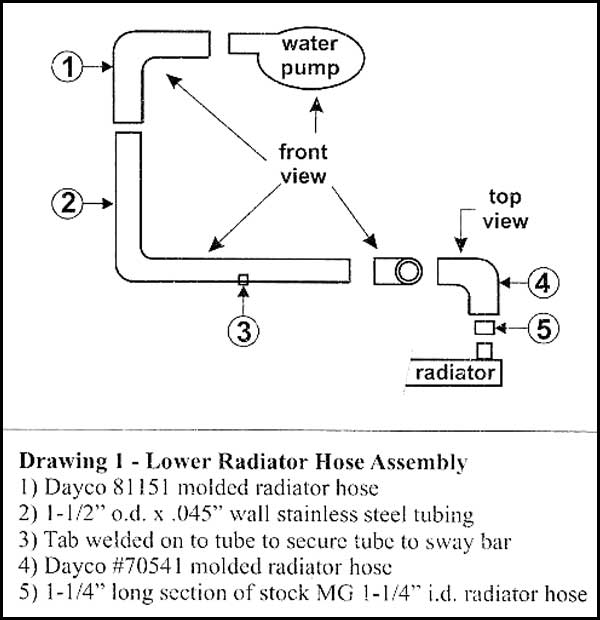
Here is the system:
Radiator - Stock 1975 MGB. Was cleaned, pressure checked and the tanks painted before installation. There were no modifications.
Water Pump - Stock Buick/Olds 215, short nose A/C version
Thermostat Housing - Stock Buick/Olds 215
Hoses - 1.5" molded radiator hoses per drawing 1. Where the 1.5" i.d. hoses were fitted over the MG radiator's 1.25" o.d. inlet and outlet necks, a 1.25" long piece of stock MG radiator hose was installed over the necks to bush them up to match the molded hose i.d.
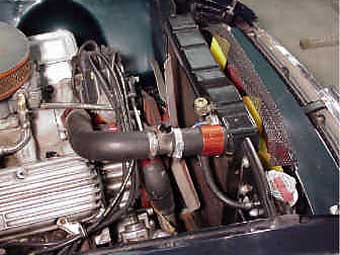
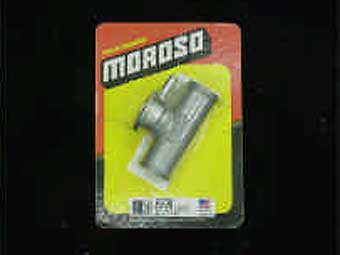
Filler Tee - To avoid air locks and to prevent air entrapment in the cooling system,
the fill point has to be the highest point in the system. If the top of the
radiator tank happens to be higher than the thermostat housing, a filler bung
installed in the tank will work well. However, in my installation, the upper
radiator hose was the highest point in the cooling system. I fabricated a
filler tee by drilling a 0.5" diameter hole in the side of a 1.5" o.d. long
section of stainless tubing. A stainless half coupling (female threaded pipe
section) was then welded over the hole and a pipe plug wrapped with Teflon tape
and installed. To fill the system I merely removed the pipe plug and slowly
poured in the antifreeze. An easy alternative to the fabricated tee is a Moroso
P/N 63730 top radiator hose tee with capper Photo2.
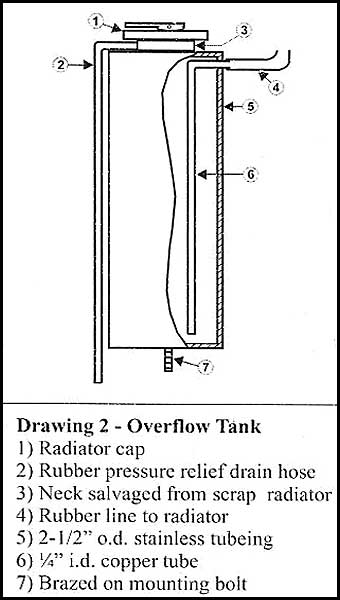
Overflow Tank - I have a fetish about keeping the engine bay as uncluttered as possible. Therefore I did not want to hang an overflow tank anywhere where it could be easily seen. The solution was another fabrication per drawing 2. The tank was installed on the passenger side and in front of the radiator support panel. The cap is easily accessed, but the tank is pretty well hidden from view.
Mechanical Fan - From a swap meet, I obtained a generic aluminum aftermarket fan. The fan diameter was a couple of inches too large and the blades interfered with the radiator necks and the hood. After a quick measurement, a compass was used to draw a smaller diameter on the blades. A three inch pneumatic cut-off wheel made short work of reducing the blade length. When performing this operation, it is imperative that the cuts are concentric and centered on the fan hub. An out-of-round blade will quickly chew up the water pump bearings.
Electrical Fan - I mounted two stock late model MGB electric fans in their normal position under the slam panel and installed an OEM mesh guard over the blades. The fans were wired into the MG thermostatic switch mounted in the top radiator tank using a late model MG wiring diagram and relay. The only alteration was the addition of a toggle switch on the dash so that the fans could be turned on manually. This was to allow triggering the fans ahead of time if a traffic jam loomed ahead.
Air Ducting - When converting a chrome bumper MGB, it is usually necessary to dish the inner fender panels to allow for header or exhaust manifold clearance. This dishing was provided by the factory in all the rubber bumper cars. Despite careful application of a bodyman's dishing hammer and hours of tapping, I ended up with the proper dish depth and configuration. However, the metal was criss-crossed with wrinkles and creases. I was afraid of laying in a layer of Bondo, as the heat and vibration would quickly cause it to crack and fall away.
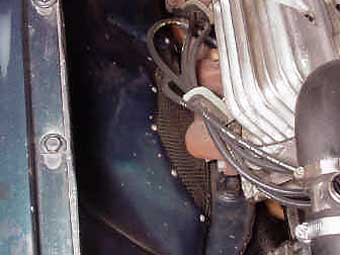
Vented MGB Inner Fender
The solution was to cut out the dish section completely, furnishing a large duct on either side, vented into the wheel. For cosmetics and to keep small animals from being flung onto the exhaust by the tires, I covered the openings with flat black painted expanded aluminum grid. (Actually gutter screen!) The grid was held in place by about 15 equally spaced aluminum pop rivets. In actuality, the ducts appear to have been intentionally installed. (Photo3)

Overflow Tank - I have a fetish about keeping the engine bay as uncluttered as possible. Therefore I did not want to hang an overflow tank anywhere where it could be easily seen. The solution was another fabrication per drawing 2. The tank was installed on the passenger side and in front of the radiator support panel. The cap is easily accessed, but the tank is pretty well hidden from view.
Mechanical Fan - From a swap meet, I obtained a generic aluminum aftermarket fan. The fan diameter was a couple of inches too large and the blades interfered with the radiator necks and the hood. After a quick measurement, a compass was used to draw a smaller diameter on the blades. A three inch pneumatic cut-off wheel made short work of reducing the blade length. When performing this operation, it is imperative that the cuts are concentric and centered on the fan hub. An out-of-round blade will quickly chew up the water pump bearings.
|
Enjoying this article? Our magazine is funded through the generous support of readers like you! To contribute to our operating budget, please click here and follow the instructions. (Suggested contribution is twenty bucks per year. Feel free to give more!) |
Electrical Fan - I mounted two stock late model MGB electric fans in their normal position under the slam panel and installed an OEM mesh guard over the blades. The fans were wired into the MG thermostatic switch mounted in the top radiator tank using a late model MG wiring diagram and relay. The only alteration was the addition of a toggle switch on the dash so that the fans could be turned on manually. This was to allow triggering the fans ahead of time if a traffic jam loomed ahead.
Air Ducting - When converting a chrome bumper MGB, it is usually necessary to dish the inner fender panels to allow for header or exhaust manifold clearance. This dishing was provided by the factory in all the rubber bumper cars. Despite careful application of a bodyman's dishing hammer and hours of tapping, I ended up with the proper dish depth and configuration. However, the metal was criss-crossed with wrinkles and creases. I was afraid of laying in a layer of Bondo, as the heat and vibration would quickly cause it to crack and fall away.

Vented MGB Inner Fender
The solution was to cut out the dish section completely, furnishing a large duct on either side, vented into the wheel. For cosmetics and to keep small animals from being flung onto the exhaust by the tires, I covered the openings with flat black painted expanded aluminum grid. (Actually gutter screen!) The grid was held in place by about 15 equally spaced aluminum pop rivets. In actuality, the ducts appear to have been intentionally installed. (Photo3)
I firmly believe that these ducts are one of the largest reasons for the
engine running cool. With the relatively large V8, steering gear and exhaust
headers, there is an easy flowpath for hot air to exit the engine bay. The
ducts help considerably in allowing air to move quickly out from under the
hood. In addition, the wheel wells are actually low pressure areas when the
MG is underway.
This condition actually "vacuums" the hot under hood air through the ducts and out of the engine bay. Several other MG V-8'ers have ducted their engine bays in a similar manner and report significantly cooler running.
Disclaimer: This page was researched and written by Kurt Schley. Views expressed are those of the author, and are provided without warrantee or guarantee. Apply at your own risk.
This condition actually "vacuums" the hot under hood air through the ducts and out of the engine bay. Several other MG V-8'ers have ducted their engine bays in a similar manner and report significantly cooler running.
Disclaimer: This page was researched and written by Kurt Schley. Views expressed are those of the author, and are provided without warrantee or guarantee. Apply at your own risk.

